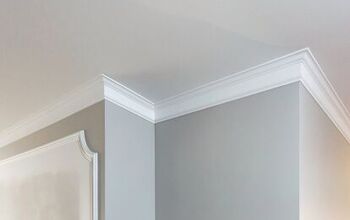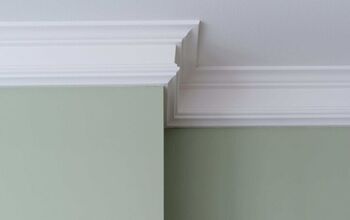Is Crown Molding Outdated? (Find Out Now!)

Crown molding has been around since the ancient Greeks and Romans were building structures, and this fact should speak to its staying power. There are, however, alternatives to crown molding, and many wonder how long crown molding will remain stylish with these alternatives gaining popularity. Here’s what we think on the question: Is crown molding outdated?
Crown molding isn’t outdated yet, as it’s still widely used for a variety of reasons. It can hide cracks, boost the visual appeal of a room, integrate wires and lighting, and even add value to a home. There are, of course, downsides to installing crown molding, such as it cracks over time and generally doesn’t go well with contemporary decor.
Do You Need Interior Trim or Decorative Molding Installation?
Get free, zero-commitment quotes from pro contractors near you.

Why Crown Molding Is Still Used Today
Crown molding is used in homes for a variety of reasons. One might cap cabinets, columns, and/or interior walls with crown molding, as this decorative finishing is quite versatile and visually appealing. When considering whether crown molding is outdated or not, one should think of the benefits of installing crown molding, which are listed below.
Hiding Imperfections
As a home ages, cracks and other blemishes appear in the walls and ceilings, especially around corners. It’s here where crown molding is most commonly applied—as a means of hiding cracks and wall blemishes. Tape lines from painting can also be masked with crown molding.
While covering cracks and other blemishes is possible, one shouldn’t look at crown molding installation as a means of fixing a deteriorating structure. If cracks along the corners of walls manifest alongside other signs of structural decay, it’s best to have a professional assess the situation. And to know which ceiling types go best with crown molding, read this post.
Visual Appeal
Crown molding gives a room architectural character. It also makes a space more elegant and inviting, which explains why you’ll see crown molding used in some of the most beautiful structures on earth.
The transition from wall to ceiling, without crown molding, is quite abrupt. With crown molding, the transition becomes drawn out, as ridges and angles show depth and prominence.
The style, design, and quality of crown molding that’s employed by a homeowner says a lot about them. Crown molding is often used as a means of personal style expression, much like how paint, flooring, lighting, windows, and furniture are too.
Boosts Home Value
Installing crown molding in your home may raise your home’s value. If the molding is constructed and installed well, then it’ll make the home more visually appealing. Exceptional crown molding might be the deciding factor for a homebuyer, and if so the buyer will surely pay top dollar for the elegance.
Furthermore, if crown molding is being employed to cover cracks and other blemishes that may dissuade a homebuyer, such can be looked at as a means of maintaining, if not boosting, a home’s value.
Hide Wiring
There’s special crown molding out there that’s wire-friendly, as in you can run wires through the molding with no hassles. This kind of special molding is constructed with a narrow channel in the middle, and it’s through this channel that the wires pass. Wire-friendly crown molding is ideal for:
- Home theaters
- Workshops
- Finished basements and garages
- Living areas with built-in audio systems
Lighting-Integrated Crown Molding
Since there’s wire-friendly crown molding, it should come as no surprise that there’s lighting-integrated molding as well. Some molding has lights built in, whereas other molding is made specifically for running lights. Lighting-integrated crown molding will provide soft, indirect light to the spaces it’s used in; these spaces are often kitchens, bathrooms, living rooms, and entertainment rooms.
Variety of Styles
Since crown molding has been around for centuries, there are hundreds of styles available. Furthermore, one can customize their molding to ensure it fits well with the decor of the room it’s used in. Some of the popular styles are:
- Plaster: This kind of crown molding is preferred because it can be cast into elaborate profiles, but it only goes well with plaster walls. Some plaster crown moldings are so pronounced and unique, wood cannot be milled to mirror them. Plaster is, however, an expensive material.
- Wood: Those who love a natural look love wood crown molding. The colors and grains of wood bring character and warmth to the rooms in which it’s used. One could use natural wood or composite wood, but in either case one can expect to pay a higher price for this kind of crown molding material.
- Medium-Density Fiberboard (MDF): This is an ideal material for painting. It’s low-cost and easy to install. If the molding has a veneer, it can be stained.
Crown Molding Downsides
Crown molding certainly has its appealing qualities, but nothing is without a downside. Below are some of the downsides which dissuade individuals from installing crown molding in their homes.
Prone to Gaps and Cracking
Crown molding is often installed to hide cracks and other blemishes that manifest on walls and ceilings, yet crown molding isn’t impervious to cracking either. A few things often cause cracks, gaps, and other blemishes to manifest in crown molding, including:
- Changing Weather: If you live in a place that experiences cold winters and hot summers, crown molding might start showing cracks and gaps just a few years after installation. This is because changing temperatures cause the molding, walls, and ceiling to warp and shift. Even the slightest misalignment can cause cracks and other unattractive defects, so crown molding should only be installed during a time of year when the temperature is mild.
- Poor Installation: Crown molding installation isn’t typically considered a DIY task. After all, an inexperienced installer could make a costly mistake if they aren’t precise. For molding that’s installed poorly, cracks and gaps are inevitable.
- Poor Materials: Crown molding that’s manufactured poorly is certainly going to lead to cracks and gaps eventually, and there may be some present before installation. Even if you purchase molding from a reputed manufacturer, it’s best to look everything over before beginning the installation. A professional can ensure you purchase and install high-quality crown molding.
Out of Place with Contemporary Decor
One of the biggest criticisms of crown molding is that it doesn’t fit well with contemporary decor. Along similar lines, some disregard crown molding as being too formal. Contemporary decor is often based on minimalism and sleekness, and one can hardly call crown molding minimalist.
Needless Expense
Crown molding doesn’t provide a major structural benefit to the home in which it’s installed, so some consider the addition of crown molding a needless expense. Unless the corners of a room are marred badly by cracks and other blemishes, installing crown molding isn’t necessary. Even then, crown molding isn’t required, as one could live with deteriorating walls and ceilings so long as there’s not a significant structural issue.
High Ceilings Only
Crown molding can be placed in a variety of locations, but that doesn’t mean it looks good everywhere. A quick browse through several online forums reveals that crown molding looks best when used with higher-than average ceilings. Crown molding does protrude, so it’s probably not the best in a room that has limited space.
Related Questions
Crown molding has been around a long time, which means plenty of questions have been asked about it. Here are some of the common ones.
Is peel-and-stick crown molding any good?Styrofoam-based crown molding can be used in a home, but this alternative is not popular. Replicating the unique styles that plaster and wood molding boast isn’t really possible. Also, stick-on molding will not last a quarter of the time wood or plastic molding last.
What should be used to fill cracks and gaps in crown molding?Standard caulk can be used to fill cracks and gaps. It’s best to use silicone caulk, as this can withstand changing temperatures well. If you have wood crown molding, it’s best to use wood filler.
Where did crown molding get its name?The term “crown molding” is a reference to the high positions on which moldings generally rest in rooms. Think of a crown being placed on a human head. The “crown” element is also a reference to the inherent elegance of the molding.
Do You Need Interior Trim or Decorative Molding Installation?
Get free, zero-commitment quotes from pro contractors near you.

Final Note
While the fascination with fixtures, furnishings, and decors ebbs and flows with each passing day, the consensus seems to indicate that crown molding is far from outdated. It has its benefits and downsides, so a decision to install it really comes down to a matter of preference. To know more about where crown molding looks good in a home, read this post.

Matt loves everything DIY. He has been learning and practicing different trades since he was a kid, and he's often the first one called when a friend or family member needs a helping hand at home. Matt loves to work with wood and stone, and landscaping is by far his most favorite pastime.
More by Matthew Mountain























![Cost To Drill A Well [Pricing Per Foot & Cost By State]](https://cdn-fastly.upgradedhome.com/media/2023/07/31/9074980/cost-to-drill-a-well-pricing-per-foot-cost-by-state.jpg?size=350x220)



